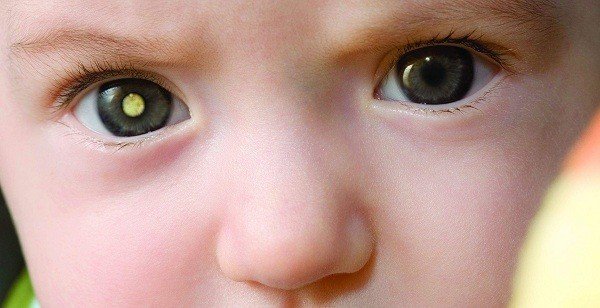Retinoblastoma

Retinoblastoma is a cancer of the eye that starts in the retina – the sensitive lining on the inside of the visual organ. The disease most often affects young children, but in rare cases it can also develop in adults.
The retina of the human eye consists of nerve light-sensitive tissue that captures the light entering from the front of the visual organ.
The retina transforms the images into nerve impulses, which by means of the optic nerve reach the visual center with the brain, where the nerve impulses are recognized.
Malignancy can develop in both eyes and is a rare form of eye cancer.
What are the symptoms?
• Appearance of a white coloration in the central circle of the eye /pupil/ when light is directed at the eyes, for example when taking pictures with a flash.
• Redness of the eyes;
• Swelling of the eyes;
• The affected person cannot direct his eyes in one direction;
What are the causes?
Malignancy occurs as a result of a mutation in the nerve cells of the retina.
These changes in the cells’ DNA cause them to grow and replicate excessively, which is not characteristic of healthy cells. This accumulation of cells with altered DNA is the reason for the formation of a tumor.
Malignant cells can invade the structures around the eye. And it is also possible for them to spread to other parts of the body such as the brain and spinal cord.
In most cases, the cause of the genetic mutations that cause retinoblastoma is not known. However, it is possible for children to inherit the modified genes from their parents.
Retinal cancer is a hereditary disease.
Gene mutations that increase the risk of malignancy can be passed from parents to children in an autosomal dominant manner, meaning that only one parent needs to carry a copy of the mutated gene to pass on the increased risk from the development of retinal cancer in children.
If one parent is a carrier of the mutated gene, each child has a 50% chance of inheriting that gene.
Although the genetic mutation increases the risk of developing the disease, this does not mean that it is inevitable.
Children with the hereditary form of retinal cancer are predisposed to developing the disease at an earlier age. And usually this form usually affects both eyes.
Treatment of retinoblastoma
When possible and the tumor is not too large, doctors try to do everything possible to preserve the child’s vision.
Chemotherapy
Therapy consists of the administration of strong drugs that destroy cancer cells. Medicines can be taken in tablet form or possibly administered intravenously.
Strong medications manage to reach every tissue of the body and kill cancer cells.
In children with retinal cancer, chemotherapy can help shrink the tumor.
And other treatment methods such as radiotherapy, cryotherapy, thermotherapy or laser therapy can be used to destroy the remaining tumor cells.
Chemotherapy may also be used when retinal malignancy has spread to tissues outside the eyeball or to other parts of the body.
Radiation therapy
They use highly ionizing radiation that targets the mutated cells to destroy them.
Two types of radiation therapy are used to treat retinal cancer:
• Internal radiation /brachytherapy/ – a small disc of radioactive material is used, which is placed in or next to the tumor, staying for several days, during which time it slowly releases radiation and irradiates the mutated cells of the tumor entity.
• External irradiation – applied only to children in whom other methods have not been effective, as it is associated with multiple side effects;



